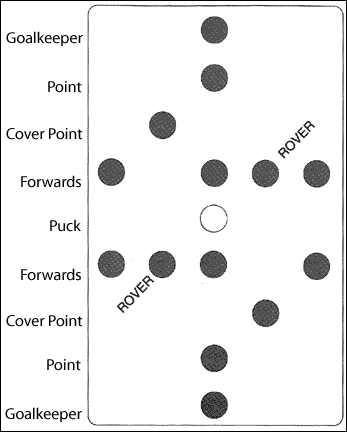Although the purpose of Ice Hockey teams has always been the same – to win – the actual structure of the team was not always as it is today. The Irish game of Hurley, from which Ice Hockey evolved, dates back to the 1300s when any number of players were allowed to take part in a contest. There was a team for every parish and they frequently challenged each other. That undoubtedly was the beginning of ‘team spirit’. So interested in playing the game were they that they went on for five centuries before they slowed down long enough to write down the rules and have them published in 1885. By then, they had confined the number of players to fifteen. Children learned to play the game early, and if they didn’t, then they never got to play, for so great are the skills required to play the game that unless they are learned early and steadily, one cannot learn them at all.
As the boys of King’s College School in Windsor began to adapt the Irish field game of Hurley to ice, it is likely that all comers were allowed to take part, just as they were on the field in Ireland. Skating had been the King’s boys’ favorite winter sport up until that time. The excitement of competition between teams, playing such an already exciting game on skates would be more than most could possibly imagine. It is probably easier for us to understand the addictive power of the challenge to play a field game on slippery ice, time after time, day after day, even if we were wearing skates. Undoubtedly they tried it with and without skates at first but we know the eventual outcome, after years of trial and error, was Canada’s great winter game, Ice Hockey.
By the time it was being played all over Nova Scotia and was being taken to other parts of Canada, definite named positions of the players had been adopted, similar to football, lacrosse, other field games in existence at the time, for Ice Hockey adopted things from several games. When the game was taken to Montreal, where it was first played inside a covered rink, the teams decided to limit the number of players to nine a side. Gradually the number reduced to seven, as follows.
First of all there was the guardian of the goal mouth, then called the Goal Tender or the Goal Keeper. In front of him and helping to guard against the other team getting close to the goal mouth were two stalwarts known as the Point and the Cover Point, the equivalents of today’s Defencemen. Then there was the front line of four, the Three Forwards and an extra player called the Rover. The Forwards carried the game to the other team, while the Rover, who was notoriously the team’s fastest skater, best stick-handler, and highest scorer, was allowed to play wherever he pleased on the ice, while the others continually tried to set him up for one man rushes. The Rover, like the other important components of the game, was a Nova Scotian innovation.

Player Positions 1800s
These seven team players were required to stay on the ice for the whole sixty minutes with a ten minute break at half time. In 1878, the game changed to three twenty-minute periods but the number of players remained the same. Used all across the country as the game became firmly established in the early 1900s, the position of Rover lost its popularity as other players improved their playing technique and developed passing plays which made the whole team stronger as a contender. Feeling that they no longer had to depend on the super skills of a single player in order to win, teams began to drop the Rover from their line up (1913 in Nova Scotia, and 1923 on the west coast). That reduced the team size to six players, a Centre, Right and Left Wing, a Right and Left Defence plus the Goalie, just as we know the positions of Ice Hockey teams today. With the onset of professionalism and the formation of the National Hockey Association in 1908 and the National Hockey League in 1917, spare players, additional lines, sub-goalies etc. altered the team as well as the game to that of today.